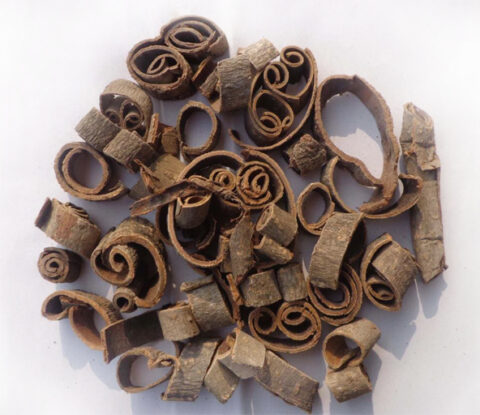
Magnolia Officinalis (Hou Po) Extract Powder 10:1, 20:1, 50:1 TLC
The functions of Magnolia officinalis in traditional Chinese medicine include drying dampness, eliminating phlegm, and removing excess qi. Used for damp stagnation injury, vomiting and diarrhea in the epigastric region, food accumulation and qi stagnation, abdominal distension and constipation, phlegm and thirst, wheezing and coughing.
Magnolia Officinalis (Hou Po) Extract Powder 10:1, 20:1, 50:1 TLC
【Other names】: Hou Po, Cortex Magnoliae Officinalis, Officinal Magnolia Bark
【Botanical source】: Magnolia officinalis Rehd.et Wils or Magnolia officinalis Rehd.et Wils.var.biloba Rehd.et Wils.
【Part used】: Dried bark, root bark, and branch bark of Magnolia officinalis Rehd.et Wils or Magnolia officinalis rehd.et Wils.var.biloba Rehd.et Wils in the Magnoliaceae family. Peel from April to June, and dry the root and branch bark directly in the shade; After slightly boiling the dried skin in boiling water, stack it in a damp place and “sweat” until the inner surface turns purple brown or brown brown. Steam until soft, take it out, roll it into a cylindrical shape, and dry it.
【Specification】: 10:1, 20:1, 50:1 TLC
【Appearance】: Brownish yellow fine powder
【Particle size】: 95% pass 80 mesh size
Magnolia officinalis (Hou Po) Extract Powder Production Flowchart
Magnolia officinalis (Hou Po) raw materials – natural air drying–Coarse powder(40 mesh) -Low temperature water extraction – 1st Reflux Extraction(10 times water,2 Hrs) – 2nd Reflux Extraction8 times water,1.5 Hrs) – 3rd Reflux Extraction(6 times water,1 Hrs) – Extraction Solution-combine&Filtrate-Concentrate-Extractum-spray drying – screening – packaging – detection of physical and chemical indicators – warehousing

Specification Sheet of Magnolia officinalis (Hou Po) Extract Powder
| Product name: | Magnolia Officinalis Extract | ||
| Specification: | 10:1 TLC | ||
| Part used: | Dried stems of Magnolia officinalis Rehd.et Wils | ||
| Solvent used: | Hot water | ||
| Process: | Raw materials crushed, extracted, concentrated and spray-dried to powder | ||
| Non GMO according to regulation (EC) 1829/2003 and 1830/2003 or United States requirements. Non allergen according to Directive 2007/68 amending Annex IIIa to Directive 2000/13/EC and US Food allergen labelling and consumer protection act 2004. | |||
| Heavy Metals: | |||
| Lead: | NMT 3ppm | Cadmium: | NMT 1ppm |
| Arsenic: | NMT 2ppm | Mercury: | NMT 1ppm |
| Residual solvents: | Comply to USP | ||
| Pesticides residues: | Conform to Regulation USP<561> | ||
| Microbiology: | |||
| Total plate count: | 10000cfu/g Max | Yeasts and molds: | 1000cfu/g Max |
| E.coli: | Not detected in (g)10 | Salmonella spp.: | Not detected in (g)25 |
| Staphylococcus aureus: | Not detected in (g)10 | Clostridium spp.: | Not Present in 0.1 g of food |
| Organoleptic quality | Method | Specifications | |
| Aspect: | Visual : ( CQ-MO-148) | Powder | |
| Color: | Visual : ( CQ-MO-148) | Brownish | |
| Flavor: | Sensory: (CQ-MO-148) | Characteristic | |
| Analytical quality | Method | Specifications | |
| Identification: | TLC | Conform | |
| Loss on drying: | USP <731> | < 10% | |
| Bulk density: | USP <616> Method I | 40 – 60 g/100mL | |
| Particle size: | Analytical sieving || USP <786> | 100% through 80meshes | |
| Packaging suitable for foodstuff. | |||
Extended Reading
Magnolia officinalis (Hou Po) Function and Efficacy Recorded in TCM
Hou Po is a very important and commonly used Qi promoting medicine in traditional Chinese medicine, especially good at treating Qi stagnation in the spleen, stomach, and lungs. Its medicinal properties are warm, bitter, and pungent, and it is suitable for the spleen, stomach, lungs, and large intestine meridians.
Its core function can be summarized as “removing fullness by descending qi”, which means eliminating symptoms such as bloating and suffocation caused by qi stagnation by pushing the qi machine downward.
The following are the detailed roles and applications of Magnolia officinalis in traditional Chinese medicine theory:
1.Relieve bloating and eliminate dryness and dampness
This is the most core and classic efficacy of Magnolia officinalis, mainly affecting the spleen and stomach in the middle burner.
Mechanism of action: Xin can disperse, Ku can reduce diarrhea, Wen can dissolve dampness. Hou Po can not only promote qi (to drive the operation of qi machines), but also reduce qi (to lower the upward flow of qi machines), and at the same time, it can also dry dampness (to eliminate dampness that hinders the spleen and stomach). When the air flows, it becomes moist, and when it becomes wet, it disappears completely.
Main applications:
Dampness obstructing the middle burner and bloating in the epigastric region: This is the absolute indication of Magnolia officinalis. When dampness and evil hinder the spleen and stomach, leading to poor qi circulation, abdominal distension, loss of appetite, and thick tongue coating, Magnolia officinalis is the preferred medication. Often combined with Atractylodes macrocephala and Chenpi, such as Pingwei San.
Food stagnation, bloating, and constipation: For those who suffer from blocked qi flow, abdominal distension, and constipation caused by food stagnation, Houpu can strongly lower qi and promote intestinal peristalsis. Often combined with rhubarb and Fructus Aurantii to form the famous Xiaochengqi Tang or Houpu Sanwu Tang.
2. Reduce stress and relieve asthma
Hou Po can not only treat spleen and stomach qi, but also lung qi.
Mechanism of action: Its bitter and descending nature can clear the upward and reverse lung qi, thereby relieving asthma.
Main applications:
Phlegm retention, wheezing, and cough: suitable for cough, wheezing, chest tightness, and excessive phlegm caused by phlegm dampness obstructing the lungs and lung qi not decreasing. Often used in combination with almonds, such as Guizhi Thickened Puxingzi Decoction, for those with unresolved symptoms and wheezing cough; Or it can be combined with ephedra, Pinellia ternata, etc.
3. Drying dampness and resolving phlegm
This is consistent with its ability to move qi and dry dampness.
Mechanism of action: By drying and eliminating dampness, the generation of phlegm is reduced from the root (traditional Chinese medicine believes that the spleen is the source of phlegm, and dampness accumulates into phlegm).
Main application: As an adjuvant drug, it is used to treat various diseases caused by excessive phlegm and dampness.
Modern Pharmacological Effects of Magnolia officinalis (Hou Po)
The modern pharmacological research of Magnolia officinalis is very in-depth, and these studies fully confirm its traditional effects such as “promoting qi and reducing bloating, drying dampness and eliminating fullness” from a scientific perspective, and reveal more potential application values.
The following are the main modern pharmacological effects of Magnolia officinalis:
1. Bi directional regulatory effect on gastrointestinal motility
This is the most direct and classic modern interpretation of the “promoting qi and reducing swelling” effect of Magnolia officinalis.
Mechanism of action:
Exciting the gastrointestinal tract (low-dose): Magnolia officinalis and its volatile oil can gently stimulate the smooth muscles of the gastrointestinal tract, enhance intestinal peristalsis, promote the emptying of intestinal contents, and alleviate bloating caused by insufficient intestinal motility.
Spasmodic and analgesic (high dose): When the intestine is painful due to spasms, the active ingredients in Magnolia officinalis (especially magnolol) can counteract intestinal smooth muscle spasms caused by acetylcholine, barium chloride, etc., thereby relieving abdominal pain.
Meaning: This unique bidirectional regulatory effect enables Magnolia officinalis to treat both bloating and constipation caused by poor intestinal motility, as well as abdominal pain caused by intestinal spasms, perfectly explaining its scientific connotation as a “necessary medicine for reducing bloating”.
2. Antibacterial and antiviral effects
Magnolia officinalis has broad-spectrum and strong antimicrobial activity, which corresponds to its efficacy in treating damp heat accumulation and stagnation.
Wide antibacterial spectrum: It has significant inhibitory effects on various Gram positive bacteria, Gram negative bacteria, and fungi, especially on bacteria that cause oral diseases and gastrointestinal infections (such as Helicobacter pylori, Staphylococcus aureus, Streptococcus, etc.).
Antiviral: It also has a certain inhibitory effect on influenza virus, hepatitis virus, etc.
Anti ulcer: Its antibacterial and anti-inflammatory effects work together to effectively inhibit gastric acid secretion, protect the gastric mucosa, and have the potential to treat gastric inflammation and ulcers.
3. Central muscle relaxation effect
This is a very prominent pharmacological characteristic of Magnolia officinalis.
Function: Houpo phenol and houpo phenol can block the spinal reflex of the central nervous system, relax skeletal muscles, and have a long-lasting effect.
Meaning: This provides the possibility for developing Magnolia officinalis as a natural, non-toxic muscle relaxant, which can be used to relieve muscle spasms, stiffness, and lower back pain. This also explains from another perspective its ability to “relieve body tension”.
4. Anti inflammatory, analgesic, and anti allergic effects
This confirms its potential in treating inflammatory pain and allergy related diseases.
Anti inflammatory: It can significantly inhibit various acute and chronic inflammation models and reduce the production of inflammatory factors such as prostaglandins and leukotrienes.
Analgesia: By means of central and peripheral mechanisms, the pain threshold is raised to produce analgesic effects.
Antiallergy: It can inhibit the release of histamine and other allergic mediators from mast cells, reducing allergic reactions.
5. Protect the central nervous system
Anti anxiety and Sedation: Magnolia officinalis extract has shown certain anti anxiety and sedative effects, which is consistent with the concept of traditional Chinese medicine that it can “lower qi” and calm the reverse qi.
Neuroprotection: Studies have shown that magnolol has a protective effect on neurons in models such as cerebral ischemia-reperfusion injury and Alzheimer’s disease, and its antioxidant and anti apoptotic mechanisms are key.
6. Other functions
Antitumor: Preliminary studies have shown that magnolol can inhibit the proliferation of various cancer cells and induce their apoptosis, such as liver cancer, gastric cancer, colon cancer, etc.
Antioxidant: It can effectively eliminate free radicals and reduce oxidative stress damage.
Cardiovascular protection: It has the effects of dilating blood vessels, inhibiting platelet aggregation, and preventing thrombosis.






